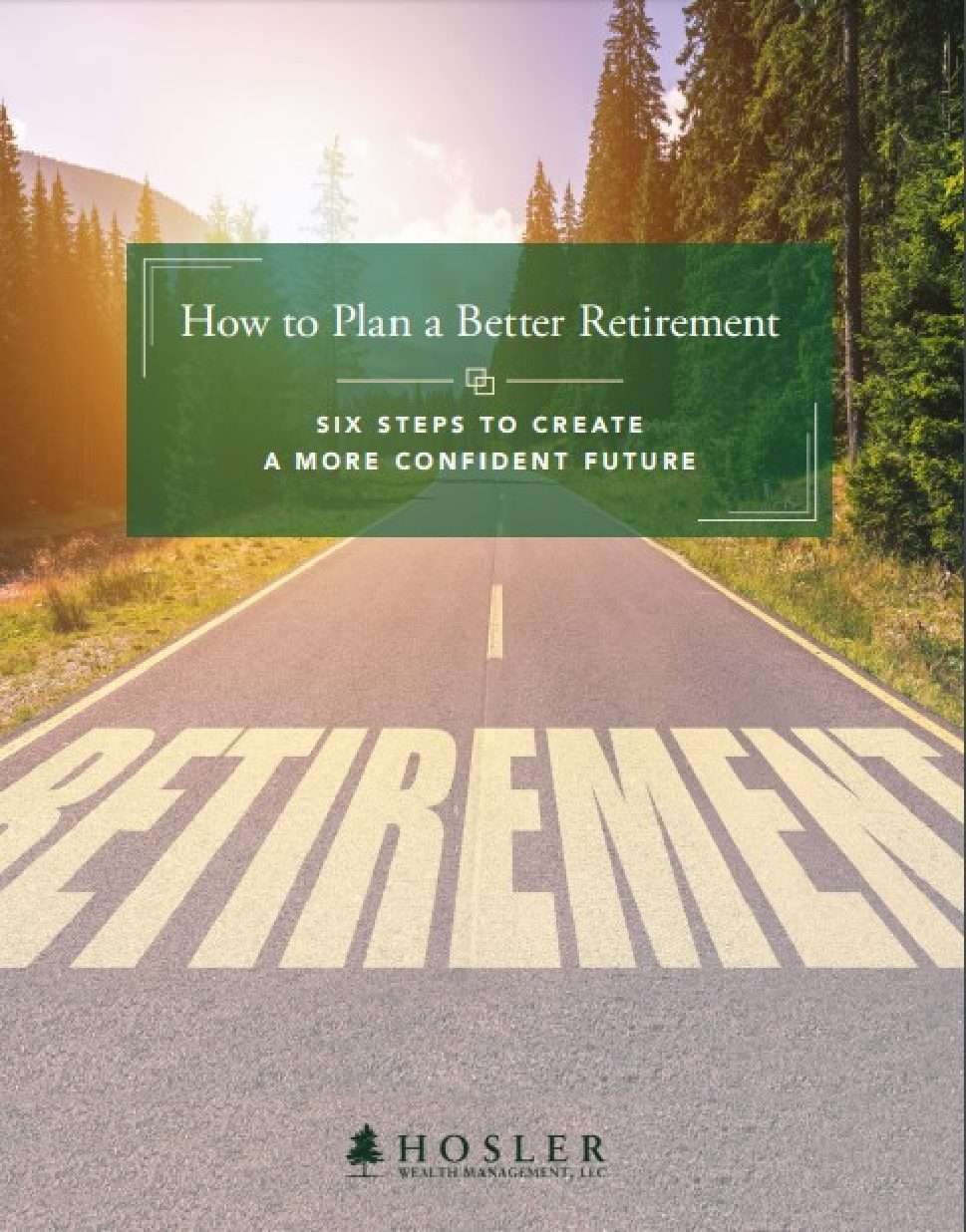Today, Jon Gay, Bruce Hosler, and Jason Hosler from Hosler Wealth Management discuss various aspects of Social Security benefits and switching strategies. They start by explaining the concept of switching benefits, which allows individuals to switch to a new benefit when they become entitled, especially if it is higher than their current benefit. They emphasize that the Social Security Administration doesn’t always notify people about switching opportunities, so individuals may not be aware of higher benefits available to them. You will hear an example of an expert who received a misleading letter from the Social Security Administration, highlighting the importance of understanding the rules.
The conversation goes into strategies for determining the best time to file for Social Security benefits, considering factors like health, life expectancy, and spousal benefits. Stressing the importance of using Social Security benefit planning software to explore various options and select the best strategy for each individual’s situation.
They also discuss the advantages of filing for benefits online and provide advice on how to communicate your intentions clearly when dealing with Social Security offices. Not all Social Security workers have experience handling complex cases, so keeping the process simple can be beneficial.Several switching opportunities are highlighted, including spousal add-ons, divorced spouse add-ons, and survivor benefits. These strategies can significantly increase the amount individuals receive in Social Security benefits. Still, they often require careful planning and knowledge of the rules.
For more information about anything related to your finances, contact Bruce Hosler and the team at Hosler Wealth Management.
Call the Prescott office at (928) 778-7666 or our Scottsdale office at (480) 994-7342.
To listen to more Protecting & Preserving Wealth podcast episodes, click here.
Limitation of Liability Disclosures: https://www.hoslerwm.com/disclosures/#socialmedia
Guest Profile

Jason Hosler holds Series 7 and 66 FINRA securities registrations. He brings a technological edge to our firm and helps many of our clients stay current in the fast-moving age of the internet.
Podcast Host

Bruce Hosler is the founder and principal of Hosler Wealth Management, LLC., which has offices in Prescott and Scottsdale, Arizona. As an Enrolled Agent, CERTIFIED FINANCIAL PLANNER™ professional, and Certified Private Wealth Advisor (CPWA®), Bruce brings a multifaceted approach to advanced financial and tax planning. He is recognized as a prominent financial professional with over 27 years of experience and a seven-time consecutive *Forbes Best-In-State Wealth Advisor in Arizona. Bruce recently authored the book MOVING TO TAX-FREE™ Strategies For Creating Tax-Free Retirement Income And Tax-Free Lifetime Legacy Income For Your Children. www.movingtotaxfree.com.
In the Protecting & Preserving Wealth podcast, Bruce and his guests discuss current financial topics and provide timely answers for our listeners.
If you have a topic of interest, please let us know by emailing info@hoslerwm.com. We welcome your suggestions.
*2018-2024 Forbes Best In State Wealth Advisors, created by SHOOK Research. Presented in April 2024 based on data gathered from June 2022 to June 2023. 23,876 were considered, 8,507 advisors were recognized. Not indicative of advisor’s future performance. Your experience may vary. For more information, please visit.
Transcript
Jon “Jag” Gay: Welcome to Protecting & Preserving Wealth. I am Jon Jag Gay, joined as always by Bruce Hosler of Hosler Wealth Management. Bruce, good to be with you.
Bruce Hosler: Jon, it’s great to be with you. Thanks for being with us today.
Jon: We are rejoined by Jason Hosler of Hosler Wealth Management. Jason, great to have you back.
Jason Hosler: Good to be back.
Jon: I see we’re talking about Social Security benefits today, specifically switching benefits. I have to admit this is a concept that I’m not familiar with. Bruce, you want to lead off with a little basic explanation here?
Bruce: Yes, certainly. If a person is ready to receive their Social Security benefits and they become entitled to a different benefit, that person may switch to the new benefit if it’s higher.
Jason: People don’t always know how or even when they can make a switch to a new benefit. The Social Security Administration always seeks to pay the highest amount to the client that they’re entitled to receive when they apply, but they don’t notify people when switching opportunities may exist. They might not know that a higher benefit is available, and I don’t think their system is set up to issue such notifications.
Bruce: Because the Social Security Administration seeks to pay the highest amount that a client is entitled to, right now when they apply, the advice from the employees of the Social Security Administration can often conflict with the advice we’re providing to clients. For example, Elaine Floyd, who is an expert on Social Security benefits, tells of her own experience. She applied for a restricted application based on her divorced spouse at her full retirement age, which currently for most people is 67 years old. As she was planning to switch back and claim her own work record later on when she reached age 70, raising her Social Security benefits significantly in the future was her plan.
A few months after she started her restricted claim on her husband’s benefits, she received an autogenerated letter from the Social Security Administration telling her that if she switched to her own work record, she could receive more current income. Now making that switch to her own record would, of course, undermine her whole Social Security benefits claiming strategy. She wisely knew to ignore the letter, but we are here today to inform people so they are not lured into making a short-sighted mistake, switching to their own record when they should be waiting until age 70, as we’ve planned for them to make the switch and receive a much higher benefit.
Jon: This, as I said earlier, Bruce, is really just a whole new world for me to get my head around. It makes me wonder, how do you know what is the best claiming strategy for your clients to take?
Jason: Well, Jon, we use a special Social Security benefit planning software to create a number of options for our clients to consider. That way they can choose from multiple choices available and select the very best claiming strategy for their specific situation.
Jon: Okay, so when is the best time to file for SSA benefits? Early age 62 so you can at least get some money before you die.
Bruce: In the financial planning world, we look at this situation closely all the time, and it depends on a couple of variables. The first one for the individual is what is your health? Is it compromised? Or do you have a family history that tells you that you may not live to the break-even age? Which for most people is around 78 to 80. Then you may want to claim your benefits before your full retirement age in order to take advantage of getting paid sooner.
Jason: On the other hand, most everyone will want to use some Social Security benefit planning between spouses in order to receive the best-combined benefit, and so that’ll usually include one of the spouses waiting until age 70 to get their full Social Security benefit and get that maximum that’s available.
Bruce: It will also provide the highest Social Security benefit for the survivor of the spouses when the first spouse dies. No matter which spouse lives the longest, they as a family have locked in the highest benefit possible for that last surviving spouse.
Jon: When someone wants to claim their Social Security benefits, should they go into the Social Security office in person or should they file online? I just got an email the other day saying, “Hey, everything’s online now. Feel free to do everything online.” How do they handle this?
Jason: That’s a good question. First of all, we want to make sure that we’re filing at the proper time, and then second, when they first apply, I think that they should try and do that online because that’s one of the easiest ways to apply. If you actually have to go into the Social Security office, you want to be armed with a copy of our Social Security planning report so it lays out the multistep claiming strategy that they have, and then they can make sure they’re informing the employees exactly what they want to do.
Bruce: Sometimes when clients go into the Social Security office trying to use a multistep claiming strategy like we’ll talk about later, they may find themselves in front of an inexperienced Social Security worker or maybe one that gets confused. Sometimes these workers may simply say, “You can’t do that.” We encourage clients when speaking to the Social Security office to just focus on the application that they’re applying for at that time. It’s okay to explain your intentions to delay your benefits to get the maximum delay credits, but if you’re filing for your initial application, you want to make it clear that that’s what you’re there to do.
Jason: Yes, it’s good to keep things simple so nobody gets confused, and those workers, they cannot refuse to take a client’s application for benefits if they’re entitled to a benefit that exists.
Jon: I like that, that you may not have somebody you’re talking to that has the most experience or understands these more complex plans. So, you just focus on, here’s what I’m doing now to keep things pretty simple and straightforward. How many times might a person apply for different Social Security benefits, Bruce?
Bruce: Over their lifetime, it can be surprising. Let me give you an example. Let’s consider a fictitious couple. Let’s say Mike and Mary, and imagine that they’re both 62 years old. That’s the earliest age that you can apply for Social Security. Let’s walk through the possible Social Security claims that they might want to make. Let’s assume also that Mike has earned more wages during his lifetime than Mary because she stayed home for a period of time while raising their children while their children were young.
Jason: In this example then, Mary would most likely want to claim her own benefits at her full retirement age at 67. Then Mike would delay claiming his benefits until age 70. After Mike receives his award letter, Mary can go online and apply for spousal benefits. She would specify the same start date as Mike. Finally, assuming Mike and Mary are like most people out there, women are just tougher than the men and they tend to outlive them. We’ll assume in this fictitious example that Mike dies at age 84. Mary then files to claim, her survivor benefit at that age.
Jon: You’re telling me that an average couple like Mike and Mary may have to apply for Social Security benefits four separate times during their lives?
Bruce: Jon that’s exactly why we’re trying to educate our listeners about that. Mary applies, Mike applies. Mary applies again on Mike’s benefits, and then she may have to apply a third time for the survivor benefit. Social Security has a lot of complex rules around this claiming, and many times they will not notify you if you’re eligible to claim an increased benefit, and sometimes they automatically will switch the recipient to a new higher benefit. Generally, that will happen when someone passes away.
Jason: Here’s a perfect example. If Mary had not been claiming a spousal benefit on Mike because her own earnings were high enough that she would have achieved a better benefit than the spousal benefit, when Mike dies, she would not have been switched to the survivor benefit automatically, because she would have been claiming on different earnings records. She was claiming on her own work record. It’s very possible that the Social Security Administration would not notify her that she’s entitled to a higher benefit if they hadn’t put it together that she’s married to Mike because they usually only see that if they’re claiming off the same record.
Bruce: In such circumstances, surviving spouses will have to make an appointment with the Social Security office to apply for their Survivor benefits because survivor benefits cannot be applied for online.
Jon: I’m glad you brought that part of it up as well, Bruce. This does sound like a huge benefit that you offer your clients at Hosler Wealth Management, helping them know when they can switch from one benefit to a new one. Are there situations when someone switching benefits would receive a huge increase?
Bruce: Jon, I read a story of a woman who was in her 70s and was receiving about $700 per month in Social Security benefits. When her advisor learned that she had been married and divorced earlier in her life and that her first marriage had lasted 10 years, the advisor told her to file for her divorced spouse benefit, which gave her another $400 a month on top of her 700. Shortly thereafter, her ex-husband died, and this increased her benefit to $2,200 per month. If the advisor had not alerted her to the divorced spouse benefit, she would still be receiving just $700 a month.
Jon: She more than tripled her money.
Bruce: Yes.
Jon: Are there other what we’d call switching opportunities, Jason, that you want to share with our listeners?
Jason: Yes. The spousal add-on is a fairly common switching strategy for the lower-earning spouse to apply for her own benefit and not get a spousal benefit at that time because her husband has not yet filed for his benefits. He may be waiting to age 70 to maximize what he takes. After he files she becomes entitled to that spousal add-on. This opportunity is often overlooked, and this opportunity is applicable where the lower-earning spouse is receiving significantly less than the higher-earning spouse.
Bruce: Now, you may have to do some math on this, folks because this benefit’s only available if the primary insurance amount of the lower-earning spouse was less than half of the primary insurance amount of the higher-earning spouse. If she claimed at age 62, she’s going to receive a reduction of 20% to 30%, and if he delayed until age 70, then there would be three years at 8% credits. Her benefit would likely be half of his. While her PIA could still have been more than half of his PIA. You have to look at what the PIA, primary insurance amount was when they both claimed originally for their benefits.
Jason: With somewhere between 24% to 37% of the population having experienced a divorce, the divorce spouse add-on is becoming a common switching opportunity for those Americans. Just like in the story that Bruce shared, it’s important to know if you had a prior marriage and if that marriage lasted at least 10 years, if you’re currently unmarried, if you meet all those criteria, you could be entitled to a divorced spousal add-on.
Jon: There are some divorcees who would prefer to forget their first marriage, but in this case, it could be a good thing.
Bruce: Right, it could very much be a big benefit. The one last big benefit that we want to speak about for married couples is the survivor benefit. Since 61% of married women will outlive their husbands, and frequently they, the women, did not work as many years due to having children and raising children, this benefit primarily applies to them because they didn’t work enough to have benefits to claim really the full benefit on their own earnings or their earnings were low so they didn’t have that big of a benefit.
If they don’t know, they can claim their deceased husband’s social security benefits, the Social Security will likely not notify them of these benefits. When a spouse dies or an ex-spouse dies and you’re not married, you’ll want to go to the Social Security office and see what benefits you can qualify for.
Jason: Got It. Now I want to make a point about the maximum retirement benefit that’s available at age 70. If a widow waited and claimed her maximum survivor benefit at her full retirement age, and if she’s a high earner, so her PIA age 70 with the late credits would exceed her survivor benefit. She filed for her deceased husband’s earnings at her full retirement age, which is usually 67, she’s going to have to go back and switch her survivor benefit to her now higher retirement benefit, and then make a claim on her own earning record.
One of the keys to this benefit is that she has to file a restricted application at her full retirement age and only apply for the survivor benefit when she first files. The Social Security Administration may try and get her to file on her own benefits, which would be higher, but remember, she’s delaying those to get the full step up at age 70, that maximum benefit. She has to make sure that she does that restricted application.
Bruce: This is truly a moment of truth when our Social Security benefit calculations come in really handy to help this widow understand the potential differences in benefits when filing a restricted claim. We’ve gone with our clients to the Social Security Office and helped them make a claim for benefits. This can be especially important in a situation as complex as this one.
Jon: That really does speak to how you at Hosler Wealth Management go above and beyond for your clients. I’ll fully admit, as a layperson having this conversation, it’s hard for me to get my head around all these variables and all these potential changes to claiming social security benefits, which is why it’s great for people who have questions to contact you at Hosler Wealth Management because you’re clearly the experts in this area. I’m sure listeners are going to have follow-up conversations for the two of you and for the team there. What are the best ways for them to contact you, Bruce, and Jason, at Hosler Wealth Management?
Bruce: It’s really easy to reach us at the website, https://hoslerwm.com. There’s a click on the little talk to us and you can get someone to respond and give you an appointment. If you’re a phone call kind of person, you can reach us on the phone at (928) 778-7666 or in Scottsdale at (480) 994-7342. Folks, if you have Social Security claiming strategy questions, we would love to have a conversation with you. I think we can bring a lot of value and help to you.
Jon: Definitely learned a lot today. Thank you both. We’ll talk again soon.
Bruce: Thanks, John.
Jason: Thank you, John.
Jon: Securities and advisory services offered through Commonwealth Financial Network, member of FINRA/SIPC, a registered investment advisor. Forward-looking commentary should not be misconstrued as investment or financial advice. The advisor associated with this podcast is not monitored for comments and any comments should be given directly to the office at the contact information specified.
Any tax advice contained in this communication, including any attachments, is not intended or written to be used and cannot be used for the purpose of, 1) avoiding federal or state tax penalties or, 2) promoting marketing or recommending to another party any transaction or matter addressed herein. The accuracy, completeness, and timeliness of the information contained in this podcast cannot be guaranteed. Accordingly, Hosler Wealth Management LLC does not warranty, guarantee, or make any representations, or assume any liability with regard to financial results based on the use of the information in this podcast.
Comments are closed.




